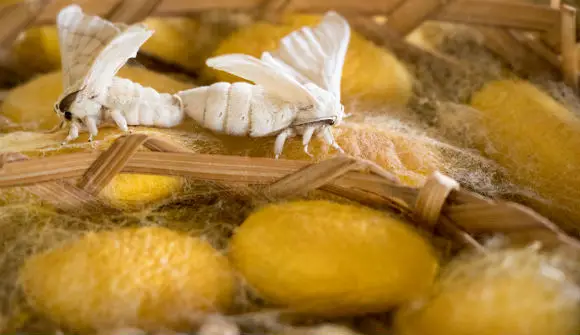Silk is the queen of fabrics but how is it made? Or what is it made of? The short answer is that it’s produced primarily by the larva of Bombyx mori, commonly known as a silkworm. The silk produced by this insect is in its raw form and undergoes a lot of processes before it can be used. Read on to find answers to these questions and many more.
Looking for a silk bed sheet set?
Check out our article about the best silk sheets in 2024 to be sure to get a high-quality product you’ll be happy with.
Alternatively, if you don’t want to read the whole article, go for highly rated Mulberry Park Silks.
Or if you’re on a budget then THXSILK bed sheet is a great option.
How To Make Silk
Here’s the step by step process of silk production.
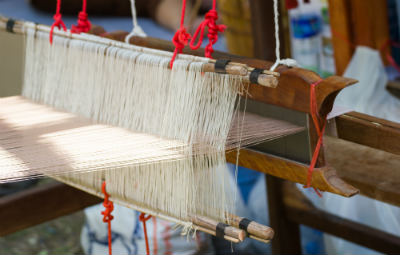
1. Sericulture
Sericulture describes the gathering of silkworms and harvesting the cocoon to collect the silk.
Female silk moths lay as many as 300 to 500 eggs at a time. After the eggs have been laid, they hatch into silkworms within a short period.
The hatched silkworms feed on a good amount of mulberry leaves to grow to their full potential of about 3 inches. Feeding and growth last for about 6 weeks after which they stop eating, begin to raise their heads and start to spin their cocoon.
The silkworm is attached to a secure frame from where it begins spinning its silk cocoon by moving its body around in a figure 8 way.
This process takes anywhere from 3 to 8 days to be completed. Each silkworm produces about 100m of silk thread and it’s held together by a natural gum called sericin.
2. Thread Extraction
After silkworms are done spinning their cocoons, they enclose themselves inside it and now is the time to extract the silk threads.
For the extraction, the cocoons are put in boiling water to soften and dissolve the gum holding the threads. Allowing the caterpillar to grow into a moth and break out will cause defects in the silk thread.
Also, this step is crucial and doing it wrong could damage the continuity of the threads. After softening the gum, each thread is then reeled in long threads from the cocoon and wound on a reel.
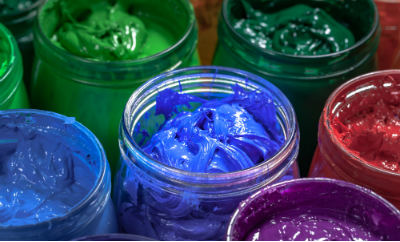
3. Dyeing
After the threads have been reeled and completely degummed, they are bleached and dried before dyeing takes place.
Traditionally, the silk is dyed with the use of natural colors from fruits or indigo leaves of plants. The thread bundles are soaked in a pot containing the coloring leaves for days multiple times. This ensures proper coloration and quality.
Nowadays, the traditional methods are no longer used for commercial silk dyeing. Manufacturers use acid dyes and reactive dyes rather than the indigo dyes from leaves and fruits. This allows a greater range of color choices to be made and in different shades too.
The general idea remains the same as the silk is soaked in a dye bath and left to absorb the color.
4. Spinning
The spinning wheel has always been and remains an important part of silk production. Although technological advancement has made it possible to spin silk faster, it still gets its basis from the spinning wheel.
Spinning unwinds the dyed threads onto a bobbin getting them ready for weaving. The different ways in which spinning can occur are hand spinning, ring spinning, and mule spinning.
5. Weaving
Weaving is the process that brings the final pieces of silk together. Silk can be woven in different ways including satin weave, plain weave, and open weave. The type of weave determines the finish of the silk.
Weaving involves crossing two sets of threads so that they go around each other and create a strong and uniform piece. The threads are woven at right angles to each other and are called a warp and a weft. The warp runs vertically while the weft runs horizontally.
6. Printing
Printing is done on silk after treatment if it needs a special design or pattern on it. Printing can either be digital or screen.
Digital printing uses a textile printer that is specially designed to use ink and transfer hand-drawn or digitally produced art onto fabrics.
Screen printing is the traditional method. It is done manually and creates a bolder and more vibrant result due to the thicker application of ink.
7. Finishing
This is the final stage before the silk is ready for use. This step gives it a lustrous sheen, making it desirable and perfect. Silk finishing is done by applying chemical treatments. These give it additional properties like fire resistance and crease proofing.
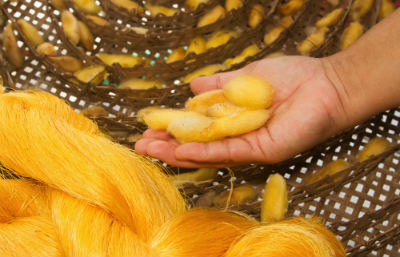
Where Is Silk Fabric Produced?
Silk is produced in different regions of the world and in varying quantities. China, according to the world atlas showing silk production holds the position as the world’s largest silk producer.
They produce 146,000 metric tonnes yearly. This is a large amount and about 5 times more than India, which is second and has a production of 28,708 metric tonnes yearly.
Uzbekistan is third and Thailand is fourth in the world among silk-producing nations.
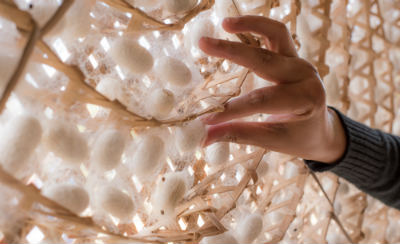
FAQ
Where Does Silk Come From?
Silk comes from silkworms which are in fact not worms but caterpillars. The caterpillars eat a lot of mulberry leaves and this helps them in silk production. After consuming enough mulberry leaves, the silkworm then makes their cocoons in 3 to 8 days.
What Is Silk Made From?
Silk is made mainly from fibroin (liquid protein) which is secreted by the silkworms. Fibroin is secreted by insects to help them make cocoons. The fibroin hardens when it comes in contact with air forming the silk fibers.
What Does A Silkworm Look Like?
A silkworm is not a worm but a caterpillar. It is called Bombyx mori. They reproduce from eggs and hatch into the lava. The body of the lava is black or dark brown with stiff little hairs.
How Is Silk Harvested?
To harvest silk, the cocoon is steamed to kill the pupae inside and preserve the continuity of the thread. It is then put in hot water to loosen the gum that holds the threads together. A machine unwinds the strands and after finishing, the thread is ready for use to weave silk cloth.
Why Is Silk So Expensive?
Silk has been around for centuries and has been sought after by many. With the introduction of synthetic materials like polyester, consumers who make use of silk expect perfection from the material.
Silk being natural has good thermal conductivity and is sturdy. It is dyed easily and doesn’t irritate the skin. All the processes from start to finish involved in silk production together with its features are responsible for its high cost.
Conclusion
So there you have it – this is how the queen of fabrics aka silk is made. It’s of great importance and has found its use in a variety of ways from robes to dresses, sheets, pillowcases, etc. It occurs naturally and is very durable and luxurious. Check out the highly rated Mulberry Park Silks or if you’re on a budget then THXSILK bed sheet to start sleeping like a Queen (or King).

